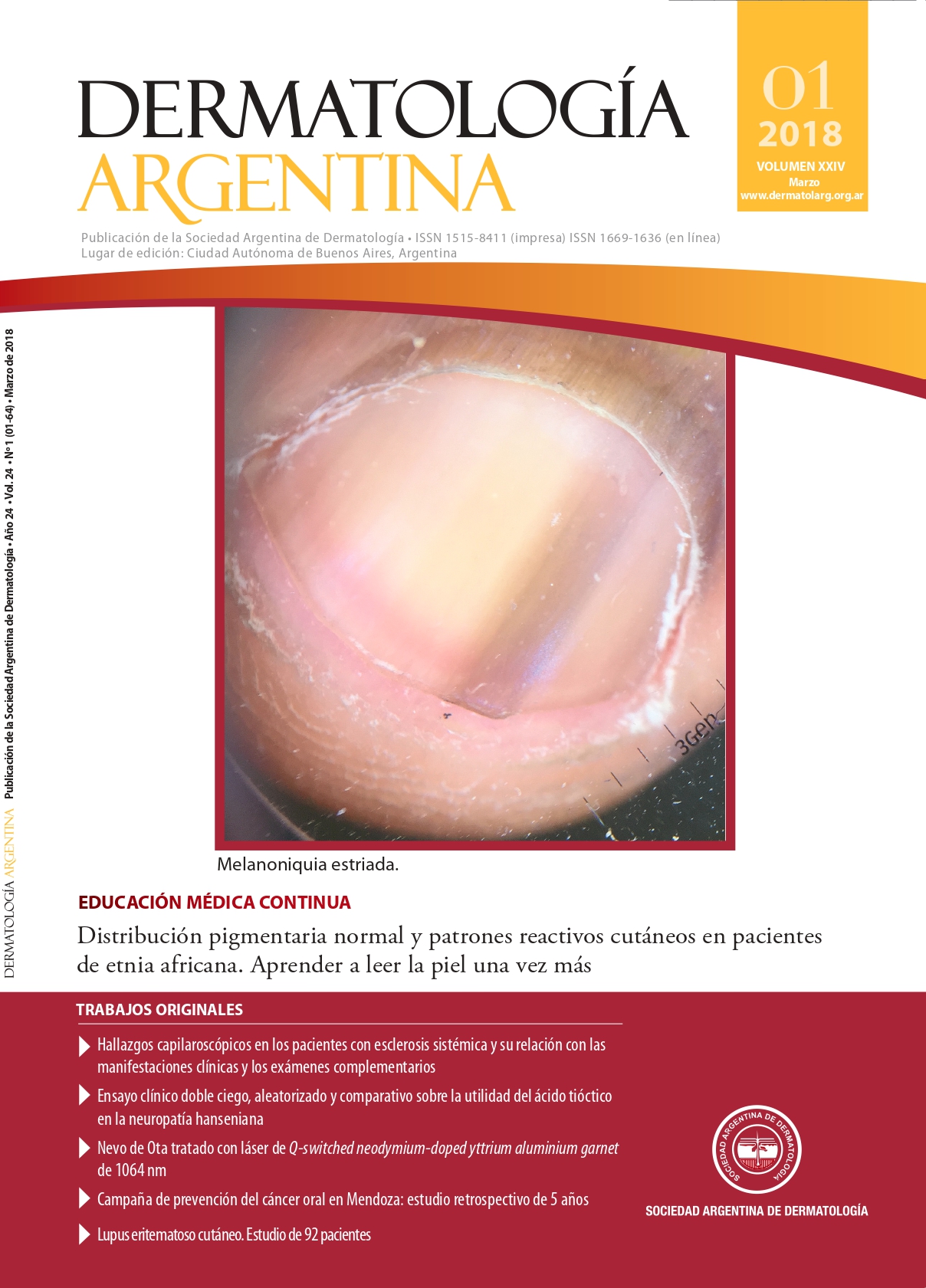Randomized, comparative, double-blind clinical trial with thioctic acid in leprosy neuropathy
Keywords:
leprosy, neuropathy, thioctic acid (AT)Abstract
Background: Mycobacterium leprae has tropism for the peripheral nervous system, where it triggers the complement cascade with activation of the proinflammatory toxin TNF alpha, neuro and myelotoxic, inducing free radicals, causing injury and destruction of the vasa nervorum.Thioctic acid (AT), a potent antioxidant, has an anti-neuritic effect, and restores decreased levels of sensitivity in diabetes.
Objectives: 1. To determine if AT 1200 mg per day improves the symptoms of patients with leprosy neuropathy with regard to dermatological, neurological and patient evaluation vs. placebo in 6 months. 2. To determine if there are significant differences in prevalence and frequency of reaction episodes.
Design: a randomized, comparative, prospective and longitudinal double-blind clinical trial with AT.
Materials and methods: surveillance patients with chronic neuropathy secondary to leprosy. Patients with acute neuritis and chronic neuropathy caused by others reasons were excluded.
Results: patient-rated symptoms of neuropathy decreased significantly over time (intra-subject), but no significant differences were found between the two treatment groups (inter-subject).
Conclusions: there were no significant differences in the dermatological and neurological evaluation. Leprosy reactions were quantified and no association was found among the given treatments either in their frequency or in their prevalence.The positive effect is the medical support in the administration of the treatment which improved the symptoms perceived by the patients.
References
I. Eichelmann K, González González SE, Salas-Alanis JC, Ocampo-Candiani J. Leprosy. An update: definition, pathogenesis, classification, diagnosis, and treatment. Actas Dermosifiliogr2013;104:554-563.
II. Garbino JA, Heise CO, Marques W Jr. Assessing nerves in leprosy. Clin Dermatol 2016;34:51-58.
III. Fischer J, Jaled M, Olivares L, Pardo Méndez N, et ál. Lepra y discapacidad grado 2. Revisión de 10 años del Servicio de Dermatología del Hospital F. J. Muñiz. Dermatol Argent2014;19:407-412.
IV. Terencio de las Aguas J. Lesiones neurales en la lepra. Monografías Dermatol 2000;13:320-328.
V. Raicher I, Stump PR, Baccarelli R, Marciano LH, et ál. Neuropathic pain in leprosy. Clin Dermatol 2016;34:59-65.
VI. Han T, Bai J, Liu W, Hu Y. Therapy of endocrine disease: a systematic review and meta-analysis of α-lipoic acid in the treatment of diabetic peripheral neuropathy. Eur J Endocrinol 2012;167:465-471.
VII. Onysko M, Legerski P, Potthoff J, Erlandson M. Targeting neuropathic pain: consider these alternatives: when patients with painful peripheral neuropathy fail to respond to –or are unable to tolerate– standard therapies, consider these lesser-known treatments. J Fam Pract 2015;64:470-476.
VIII. Koufaki M. Therapeutic applications of lipoic acid: a patent review (2011-2014). Expert Opin Ther Pat 2014;24:993-1005.
IX. Bartkoski S, Day M. Alpha-lipoic acid for treatment of diabetic peripheral neuropathy. Am Fam Physician 2016;93:786.
X. Papanas N, Ziegler D. Efficacy of α-lipoic acid in diabetic neuropathy. Expert Opin Pharmacother 2014;15:2721-2731.
XI. Olivares L, Carabajal MT, Jaled M, Iriarte A, et ál. Estudio retrospectivo a 10 años (1996-2005) de enfermos con lepra. Hospital F. J. Muñiz. Dermatol Argent 2006;12:280-285.
XII. Del Arco R, De Oliveira AB, Nardi SM, Paschoal VD. The association between neuropathic pain and disability grades in leprosy. Lepr Rev2016;87:53-59.
XIII. Andre PR, Stump G, Dalbe G. Mechanisms and clinical management of pain. Braz Oral Res 2012;26:115-119.
XIV. Martínez-Salio A, De la Cámara AG, Canudas MVR, Homs JM, et ál.Diagnóstico y tratamiento del dolor neuropático. Med Clín (Barc)2009;133:629-636.
XV. Del Arco R, Nardi SM, Bassi TG, Paschoal VD. Diagnosis and medical treatment of neuropathic pain in leprosy. Rev Lat Am Enfermagem2016;8:24.
XVI. Cruciani RA, Nieto MJ. Fisiopatología y tratamiento del dolor neuropático: avances más recientes. Rev Soc Esp Dolor 2006;13:312-327.
XVII. Olivares LM. Lepra reaccional. Dermatol Argent 2004;10:94-101.
XVIII. Flores OR. La reacción leprosa: una revisión. Dermatol Venezol 2000;38.
XIX. Nascimento OJ. Leprosy neuropathy: clinical presentations. Arq Neuropsiquiat 2013;71:661-666.
XX. Husain S, Malaviya GN. Early nerve damage in leprosy: An electrophysiological study of ulnar and median nerves in patients with and without clinical neural deficits. Neurol India 2007;55:22-26.
XXI. Olivares L, Pizzariello G, D’Atri G, Martínez A, et ál. Lepra reaccional. Dermatol Argent 2009;15:125-130.
XXII. Aldinio V, Etchevers ME, Fiestas JAH, Zubiri V, et ál. Análisis clínico-epidemiológico en pacientes con polineuropatía asociada a lepra. Neurol Argent 2015;7:156-160.
Downloads
Published
Issue
Section
License
Copyright (c) 2018 Argentine Society of Dermatology

This work is licensed under a Creative Commons Attribution-NonCommercial-NoDerivatives 4.0 International License.
El/los autor/es tranfieren todos los derechos de autor del manuscrito arriba mencionado a Dermatología Argentina en el caso de que el trabajo sea publicado. El/los autor/es declaran que el artículo es original, que no infringe ningún derecho de propiedad intelectual u otros derechos de terceros, que no se encuentra bajo consideración de otra revista y que no ha sido previamente publicado.
Le solicitamos haga click aquí para imprimir, firmar y enviar por correo postal la transferencia de los derechos de autor













